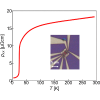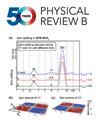Unconventional anomalous Hall effect in a triangular lattice antiferromagnet
IF 3.7
2区 物理与天体物理
Q1 Physics and Astronomy
引用次数: 0
Abstract
We studied the electrical transport properties of a classical spin triangular lattice antiferromagnet . In this material, a unique spin structure with a five-sublattice unit cell emerges below the Néel temperature , owing to frustration from strong further-neighbor interactions. The material also exhibits unique electrical transport properties coupled with its magnetism, due to a highly conductive layer of . Here, we report magnetoresistance and the Hall effect in flake devices below and above up to a magnetic field of 8 T. A large magnetoresistance and anomalous Hall effect were observed in the vicinity of , indicating that the fluctuation of the magnetic moments plays a key role. We propose possible scenarios in which the anomalous Hall effect is enhanced through thermal fluctuation.

三角晶格反铁磁体中的非常规反常霍尔效应
我们研究了经典自旋三角形晶格反铁磁体 Ag2CrO2 的电输运特性。在这种材料中,由于强远邻相互作用产生的挫折,在奈尔温度 TN 以下出现了一种独特的自旋结构,即五子晶格单元格。由于具有一层高导电性的 Ag2,这种材料还表现出与磁性相耦合的独特电气传输特性。在这里,我们报告了在磁场高达 8 T 的 TN 以下和 TN 以上的 Ag2CrO2 片状器件中的磁阻和霍尔效应。在 TN 附近观察到了较大的磁阻和异常霍尔效应,这表明磁矩的波动起了关键作用。我们提出了通过热波动增强反常霍尔效应的可能方案。
本文章由计算机程序翻译,如有差异,请以英文原文为准。
求助全文
约1分钟内获得全文
求助全文
来源期刊

Physical Review B
物理-物理:凝聚态物理
CiteScore
6.70
自引率
32.40%
发文量
0
审稿时长
3.0 months
期刊介绍:
Physical Review B (PRB) is the world’s largest dedicated physics journal, publishing approximately 100 new, high-quality papers each week. The most highly cited journal in condensed matter physics, PRB provides outstanding depth and breadth of coverage, combined with unrivaled context and background for ongoing research by scientists worldwide.
PRB covers the full range of condensed matter, materials physics, and related subfields, including:
-Structure and phase transitions
-Ferroelectrics and multiferroics
-Disordered systems and alloys
-Magnetism
-Superconductivity
-Electronic structure, photonics, and metamaterials
-Semiconductors and mesoscopic systems
-Surfaces, nanoscience, and two-dimensional materials
-Topological states of matter
 求助内容:
求助内容: 应助结果提醒方式:
应助结果提醒方式:


